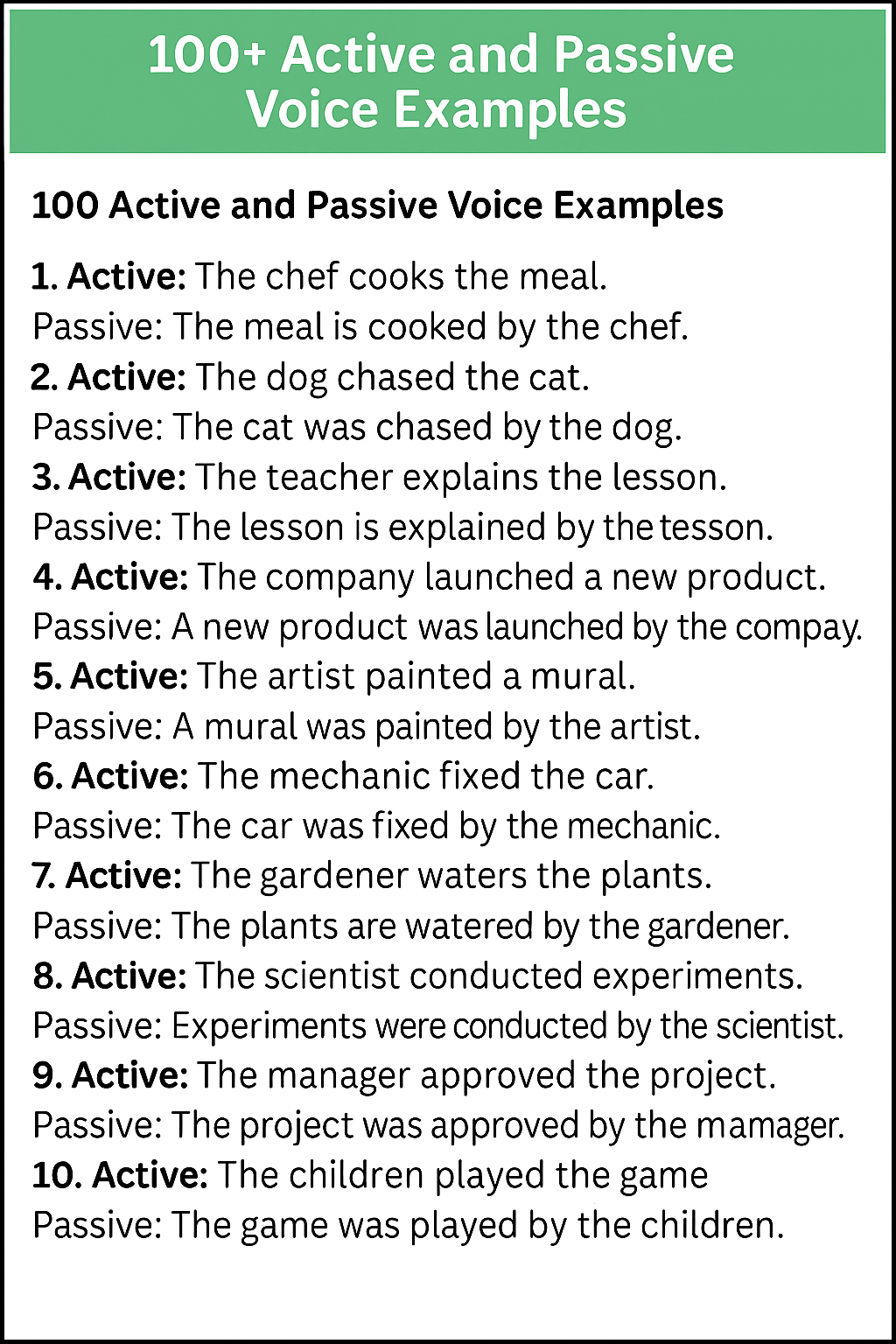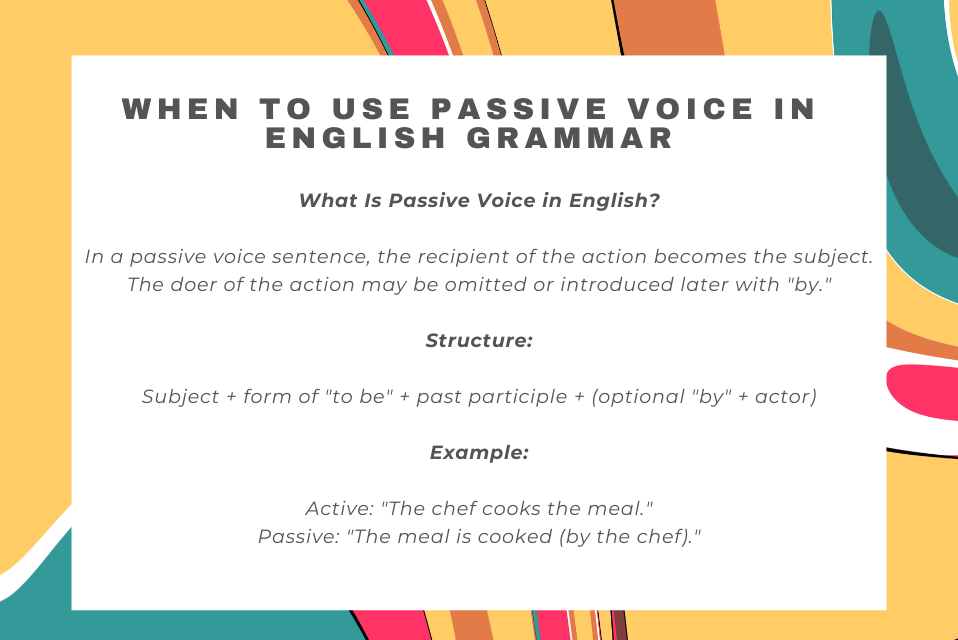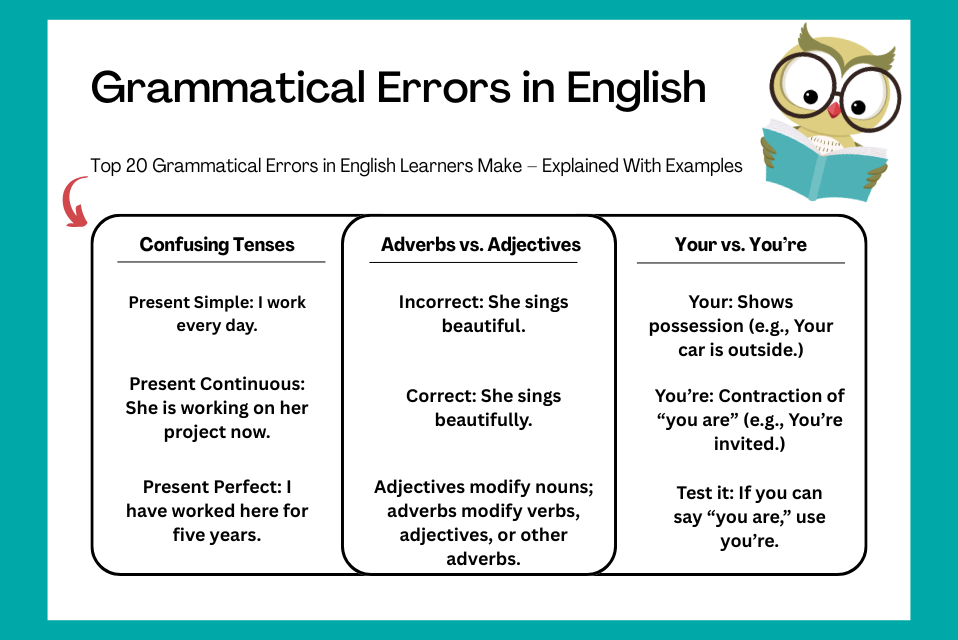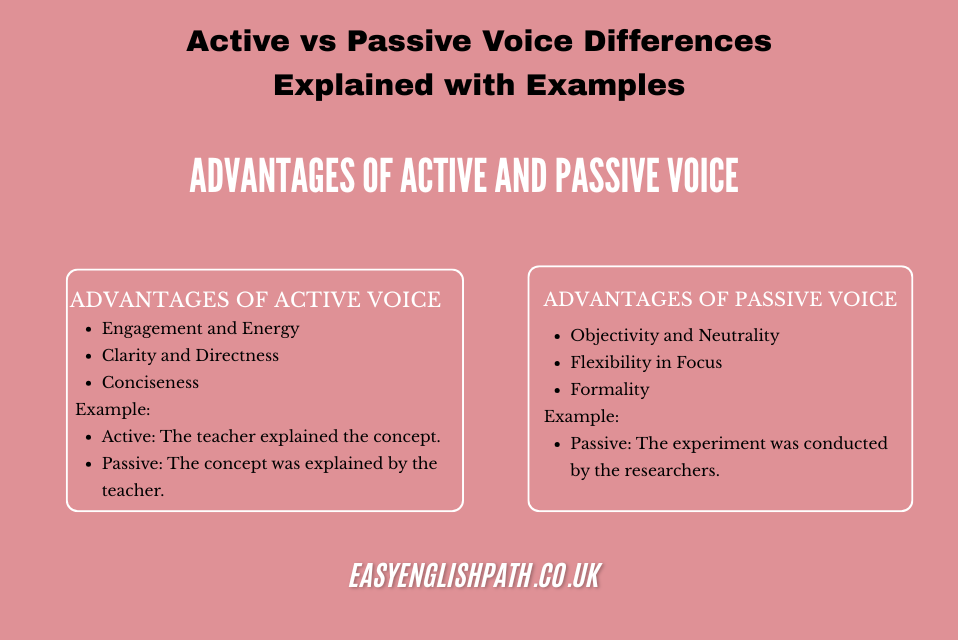Active and passive voice are two key elements of grammar that play an important role in how we communicate. Understanding the difference between these two voices is crucial for writing clear, effective, and engaging content. Active voice generally makes writing direct and dynamic, while passive voice can sometimes be used for emphasis or to focus on the action rather than the subject.
In this article, we will provide over 100 Active and Passive Voice Examples to help you better understand how to use them. By the end of this article, you’ll have a strong grasp of how to choose the appropriate voice for different situations and how to switch between them effectively.
100 Active and Passive Voice Examples

- Active: The chef cooks the meal.
Passive: The meal is cooked by the chef. - Active: The dog chased the cat.
Passive: The cat was chased by the dog. - Active: The teacher explains the lesson.
Passive: The lesson is explained by the teacher. - Active: The company launched a new product.
Passive: A new product was launched by the company. - Active: The artist painted a mural.
Passive: A mural was painted by the artist. - Active: The mechanic fixed the car.
Passive: The car was fixed by the mechanic. - Active: The gardener waters the plants.
Passive: The plants are watered by the gardener. - Active: The scientist conducted experiments.
Passive: Experiments were conducted by the scientist. - Active: The manager approved the project.
Passive: The project was approved by the manager. - Active: The children played the game.
Passive: The game was played by the children. - Active: The students are writing essays.
Passive: Essays are being written by the students. - Active: The chef is preparing the ingredients.
Passive: The ingredients are being prepared by the chef. - Active: The team won the championship.
Passive: The championship was won by the team. - Active: The children were drawing pictures.
Passive: Pictures were being drawn by the children. - Active: The engineer has designed the bridge.
Passive: The bridge has been designed by the engineer. - Active: The committee will review the proposal.
Passive: The proposal will be reviewed by the committee. - Active: The author wrote the book.
Passive: The book was written by the author. - Active: The librarian organized the books.
Passive: The books were organized by the librarian. - Active: The police arrested the suspect.
Passive: The suspect was arrested by the police. - Active: The company is launching a new campaign.
Passive: A new campaign is being launched by the company. - Active: The doctor treated the patient.
Passive: The patient was treated by the doctor. - Active: The maid cleans the house.
Passive: The house is cleaned by the maid. - Active: The secretary typed the report.
Passive: The report was typed by the secretary. - Active: The volunteers distributed the flyers.
Passive: The flyers were distributed by the volunteers. - Active: The waiter served the meal.
Passive: The meal was served by the waiter. - Active: The designer created the logo.
Passive: The logo was created by the designer. - Active: The farmer grows vegetables.
Passive: Vegetables are grown by the farmer. - Active: The singer sang the song.
Passive: The song was sung by the singer. - Active: The pilot flew the plane.
Passive: The plane was flown by the pilot. - Active: The lawyer won the case.
Passive: The case was won by the lawyer. - Active: The teacher is grading the exams.
Passive: The exams are being graded by the teacher. - Active: The artist is drawing a portrait.
Passive: A portrait is being drawn by the artist. - Active: The construction crew built the house.
Passive: The house was built by the construction cr - Active: The tailor sewed the dress.
Passive: The dress was sewn by the tailor. - Active: The author has published a novel.
Passive: A novel has been published by the author. - Active: The chef will cook the dinner.
Passive: The dinner will be cooked by the chef. - Active: The player hit the ball.
Passive: The ball was hit by the player. - Active: The photographer took the picture.
Passive: The picture was taken by the photographer. - Active: The editor reviewed the article.
Passive: The article was reviewed by the editor. - Active: The director produced the movie.
Passive: The movie was produced by the director. - Active: The guard protected the building.
Passive: The building was protected by the guard. - Active: The actor performed the role.
Passive: The role was performed by the actor. - Active: The scientist discovered the formula.
Passive: The formula was discovered by the scientist. - Active: The writer wrote the script.
Passive: The script was written by the writer. - Active: The nurse cared for the patients.
Passive: The patients were cared for by the nurse. - Active: The instructor taught the class.
Passive: The class was taught by the instructor. - Active: The chef has prepared the meal.
Passive: The meal has been prepared by the chef. - Active: The manager will sign the contract.
Passive: The contract will be signed by the manager. - Active: The team played the match.
Passive: The match was played by the team. - Active: The coach trained the athletes.
Passive: The athletes were trained by the coach. - Active: The artist has painted a masterpiece.
Passive: A masterpiece has been painted by the artist. - Active: The technician repaired the device.
Passive: The device was repaired by the technician. - Active: The student answered the question.
Passive: The question was answered by the student. - Active: The chef is baking the cake.
Passive: The cake is being baked by the chef. - Active: The engineer designed the system.
Passive: The system was designed by the engineer. - Active: The plumber fixed the leak.
Passive: The leak was fixed by the plumber. - Active: The architect drew the plans.
Passive: The plans were drawn by the architect. - Active: The team will present the project.
Passive: The project will be presented by the team. - Active: The student solved the problem.
Passive: The problem was solved by the student. - Active: The musician composed the song.
Passive: The song was composed by the musician. - Active: The reporter wrote the article.
Passive: The article was written by the reporter. - Active: The programmer developed the app.
Passive: The app was developed by the programmer. - Active: The chef is preparing the dessert.
Passive: The dessert is being prepared by the chef. - Active: The teacher has given the instructions.
Passive: The instructions have been given by the teacher. - Active: The students completed the assignment.
Passive: The assignment was completed by the students. - Active: The painter painted the house.
Passive: The house was painted by the painter. - Active: The author wrote the story.
Passive: The story was written by the author. - Active: The gardener trimmed the bushes.
Passive: The bushes were trimmed by the gardener. - Active: The technician installed the software.
Passive: The software was installed by the technician. - Active: The chef cooked the steak.
Passive: The steak was cooked by the chef. - Active: The lawyer argued the case.
Passive: The case was argued by the lawyer. - Active: The team scored the winning goal.
Passive: The winning goal was scored by the team. - Active: The doctor diagnosed the illness.
Passive: The illness was diagnosed by the doctor. - Active: The author signed the book.
Passive: The book was signed by the author. - Active: The judge delivered the verdict.
Passive: The verdict was delivered by the judge. - Active: The chef plated the dish.
Passive: The dish was plated by the chef. - Active: The actor delivered the lines.
Passive: The lines were delivered by the actor. - Active: The company built the new office.
Passive: The new office was built by the company. - Active: The writer drafted the proposal.
Passive: The proposal was drafted by the writer. - Active: The artist sketched the portrait.
Passive: The portrait was sketched by the artist. - Active: The team developed the strategy.
Passive: The strategy was developed by the team. - Active: The chef served the dessert.
Passive: The dessert was served by the chef. - Active: The professor lectured the students.
Passive: The students were lectured by the professor. - Active: The musician played the instrument.
Passive: The instrument was played by the musician. - Active: The scientist tested the hypothesis.
Passive: The hypothesis was tested by the scientist. - Active: The photographer captured the moment.
Passive: The moment was captured by the photographer. - Active: The programmer wrote the code.
Passive: The code was written by the programmer. - Active: The teacher reviewed the homework.
Passive: The homework was reviewed by the teacher. - Active: The architect designed the building.
Passive: The building was designed by the architect. - Active: The gardener planted the flowers.
Passive: The flowers were planted by the gardener. - Active: The chef marinated the chicken.
Passive: The chicken was marinated by the chef. - Active: The athlete won the race.
Passive: The race was won by the athlete. - Active: The artist exhibited the painting.
Passive: The painting was exhibited by the artist. - Active: The baker baked the bread.
Passive: The bread was baked by the baker. - Active: The student answered the question.
Passive: The question was answered by the student. - Active: The nurse administered the medication.
Passive: The medication was administered by the nurse. - Active: The designer illustrated the book.
Passive: The book was illustrated by the designer. - Active: The team built the bridge.
Passive: The bridge was built by the team. - Active: The musician composed the symphony.
Passive: The symphony was composed by the musician. - Active: The programmer updated the software.
Passive: The software was updated by the programmer.
How to Convert Active Voice to Passive Voice
- Identify the subject, verb, and object in the active sentence.
- Example: The teacher explains the lesson.
- Subject: The teacher
- Verb: explains
- Object: the lesson
2. Move the object to the subject position in the passive sentence.
- Passive Step 1: The lesson…
3. Use the correct form of the verb “to be” + past participle of the main verb according to the tense.
- Passive Step 2: The lesson is explained…
4. Optionally add the original subject with “by” if necessary.
- Passive Step 3: The lesson is explained by the teacher.
Important Tips When Converting
- Keep the verb tense consistent when changing from active to passive.
- Use “by” to indicate the doer, but it can be omitted if unknown or irrelevant.
- Intransitive verbs (verbs without an object) cannot be turned into passive voice.
- Example: She sleeps. (No passive form)
Examples of Active and Passive Voice Across Tenses
| Tense | Active Example | Passive Example |
| Simple Present | The teacher explains the lesson. | The lesson is explained by the teacher. |
| Present Continuous | The chef is cooking the meal. | The meal is being cooked by the chef. |
| Present Perfect | She has completed the assignment. | The assignment has been completed by her. |
| Simple Past | The chef cooked the meal. | The meal was cooked by the chef. |
| Past Continuous | The chef was cooking the meal. | The meal was being cooked by the chef. |
| Past Perfect | The chef had cooked the meal. | The meal had been cooked by the chef. |
| Simple Future | The team will complete the project. | The project will be completed by the team. |
| Future Continuous | The chef will be cooking the meal. | The meal will be being cooked by the chef. |
| Future Perfect | The chef will have cooked the meal. | The meal will have been cooked by the chef. |
Conclusion
Mastering active and passive voice improves the clarity and tone of your writing. Use active voice to make your writing direct and lively. Use passive voice when the action or receiver is more important than the doer, especially in formal or academic contexts.
Keep practicing switching between active and passive forms across tenses, and you’ll soon gain confidence in using both effectively.
FAQS: 100 Active and Passive Voice Examples
1. What is the difference between active and passive voice?
Answer: In active voice, the subject performs the action (e.g., The chef cooks the meal). In passive voice, the subject receives the action (e.g., The meal is cooked by the chef).
2. When should I use active voice?
Answer: Use active voice when you want your writing to be clear, direct, and dynamic. It is generally preferred in most types of writing, especially in informal and creative contexts.
3. When is passive voice appropriate?
Answer: Passive voice is useful when the focus is on the action or the object rather than the subject, or when the doer is unknown, unimportant, or implied. It is often used in scientific, technical, or formal writing.







